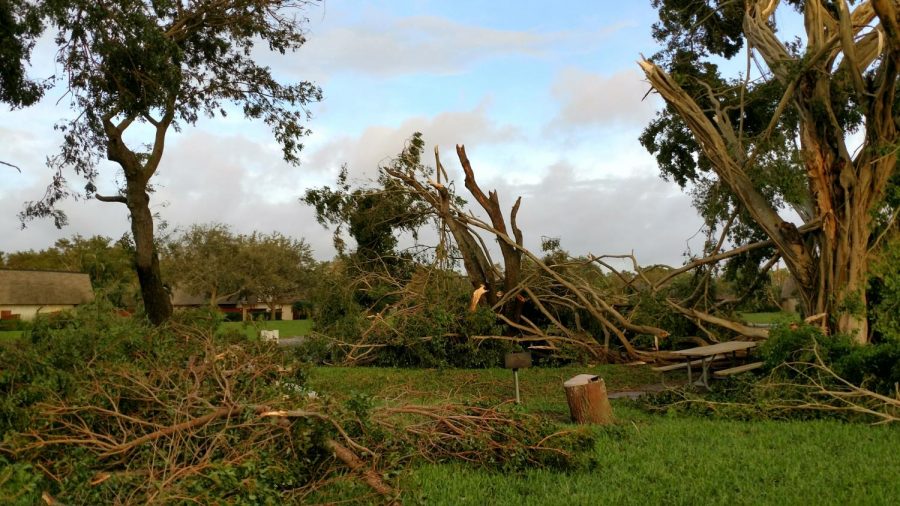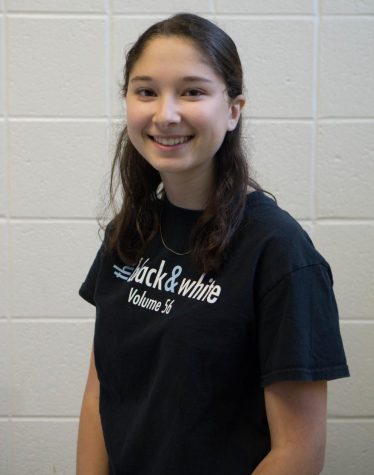Successive hurricanes devastate U.S., Puerto Rico, Caribbean
Fallen trees scatter a neighborhood in De;ray Beach, Florida. Hurricane Harvey, Irma and Maria all led to widespread tree damage, power outages and flooding. Photo courtesy Jill Kittredge.
October 1, 2017
It took just five minutes for four and one half feet of water to flood Houston 8th-grader Emma Daves’ home. Outside, the ashen sky swelled, cloaking the city in a gray light. Winds toppled homes like dominoes and roadways morphed into riverbeds. Across Texas, residents braced for the impact as Hurricane Harvey devastated the coast Aug. 25 to 29, destroying the homes, cars, and lives of millions of coastal residents.
“One second we were all dry, and ten seconds later there was water coming in from the walls and the door,” Daves said. “It’s kind of weird not having a home to go to every night. All of our stuff that we’ve worked for is ruined.”
As floodwaters recede and gaping sinkholes emerge, Daves—and the other residents of the nation’s fourth-largest city—now grapple with devastation, recovery and restoration.
Her piano upturned, her stepfather’s journal destroyed and her neighborhood in ruins, Daves can’t return to her either of her parents’ homes, as both will be uninhabitable for a year, she said. For now, she divides her time between a rental home and an apartment.
A unified response
Daves’ story is not unlike those of countless others with homes left damaged or destroyed by the Category 4 storm.
River Oaks Baptist School Reading Specialist Rhonda Hill’s garage filled with seven inches of water, and her neighborhood became strewn with debris. But for Hill, Harvey represents much more than a natural disaster; it has elicited a collective response in a “divided nation,” she said.
“The amazing part of it is how it has unified our city and our neighborhood,” Hill said. “We didn’t really see the negative as much—yes, there is the aftermath and the clean-up—but we got to know our neighbors so much better. The relationship building outweighed the devastation.”
Halfway across the country, that unifying spirit moved farmer Michael Portas to come to Houston’s aid. While farmers of agriculturally-rich Texas grapple with lost crops and livestock, Portas—the owner of One Acre Farm in Boyds, Md.—decided to fulfill an unmet need: bringing livestock displaced by the storm to his vegetable farm.
With the help of volunteers from Washington Hebrew Congregation, Portas loaded a livestock truck with diapers, cleaning supplies, and 10,000 prepared meals. On his return trip, he brought cattle to his farm.
When he arrived in Houston, thousands of other volunteers greeted him, all sharing his goal, he said.
“You’re proud of yourself, but you get there and you’re one of a million people that are coming.“It was neat because it wasn’t special, he said. “So many people have come together to do these things, which makes it even more special, even though you’re not special by doing it.”
Before the storm hit, Houston’s Rice University canceled classes and rationed food. Rice borders Texas Medical Center, a medical district designed to withstand floods, but when Harvey made landfall, Rice freshman Ella Segal (‘17) and her roommates huddled in their bathroom, riding out small tornados as water collected on their bathroom floor.
Hurricanes Irma and Maria make landfall
Following Harvey, Hurricane Irma devastated the Leeward Islands, the Florida Keys, and mainland Florida Aug. 30 to Sept. 15, leaving several Caribbean islands in ruins and 6.5 million Floridians without power.
“I’ve lived in my community for twenty years, and we had trees that were completely knocked over,” Delray Beach resident Jill Kittredge said. “These trees were over a hundred years old, so it’s a little bit heartbreaking. There’s so much tree damage, the community looks bald.”
In Dominica, Puerto Rico and Turks and Caicos, Hurricane Maria made landfall Sept. 19. In Puerto Rico, the Category 4 storm sustained winds of 125 miles per hour. Residents will be without power for months, newspapers reported.
“I’ve covered all three Hurricanes: Harvey, Irma and Maria, and the situation in Puerto Rico is much worse than the situations ever were in Florida and in Texas,” Washington Post reporter Joel Achenbach said. “They lost all electrical power, plus they lost the radar in the airport and the control tower. It’s really hard to get aid in and out of there. There’s a population of three and a half million people, there’s no electrical grid, small towns and villages are hard to reach because of the fallen trees. You have a disastrous situation from start to finish.”
Houstonians, Floridians and Puerto Ricans now face a new normal. With up to a million waterlogged cars, many residents of automobile-dependent Houston remain trapped in their homes. For those whose cars could be salvaged, traffic congestion will plague the city for weeks, Harvey victim Kilby Hoskins said.
“Getting to the grocery store and seeing that there are no eggs—that’s what happened to us yesterday,” Houston resident Shelby Hammer said. “You’re like, ‘okay, there are no eggs, that’s alright. I’ll come up with something else.’ There are all kinds of little things that you took for granted before that you can’t necessarily take for granted now. That’s the new normal.”
In Houston, excessive paving, deforestation and inadequate building codes exacerbated the damage by limiting floodwater ground absorption, said Andrew Wallace, general counsel at a Dallas infrastructure company. But Wallace is optimistic that the damage will be a catalyst for infrastructural improvements.
The impact of climate change
In these successive hurricanes, climate change plays a decisive role, Fernando Miralles-Wilhelm, Interim Director of the University of Maryland’s Cooperative Institute for Climate and Satellites, said.
“Climate change worsens the intensity of these storms: stronger winds, more precipitation. These storms aren’t going to go away, and they’re not going to get milder anytime soon,” Miralles-Wilhelm said. “The only way for us to deal with them is to become better prepared and have better forecasting capabilities.”
Compounding this chain of destruction is a magnitude 7.1 earthquake that rocked central Mexico September 19. With a death toll surpassing 270, Mexico’s search for survivors is far from finished.
Despite the massive destruction, many hurricane victims have said they feel lucky; amid the devastation, their lives and loved ones were spared.
“At the end of the day, you realize that a rug from Pottery Barn is not that important,” Hoskins said. “Some of the material items that we think we have to have, when you see things that people lose, you see what is really important in life.”
Donations can be made to the Red Cross, Puerto Rican and Dominican charities like Unidos por Puerto Rico and Dominica Hurricane Relief Fund, and global charities like AmeriCares and GlobalGiving.









